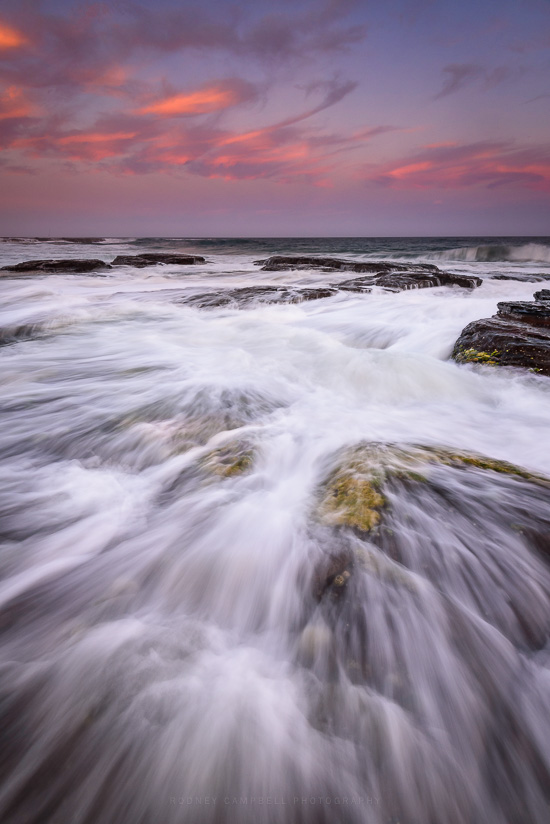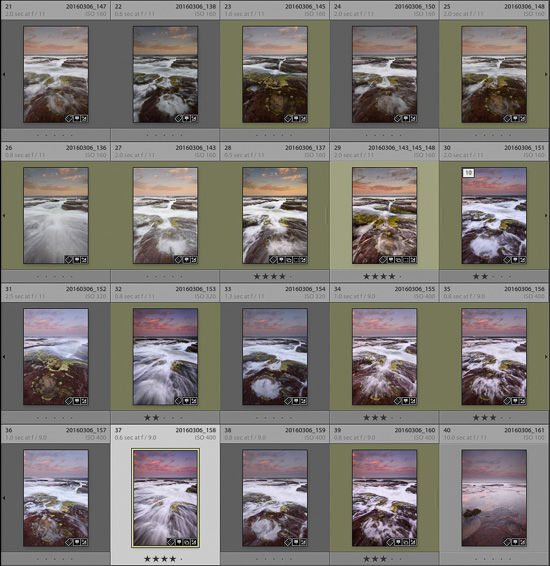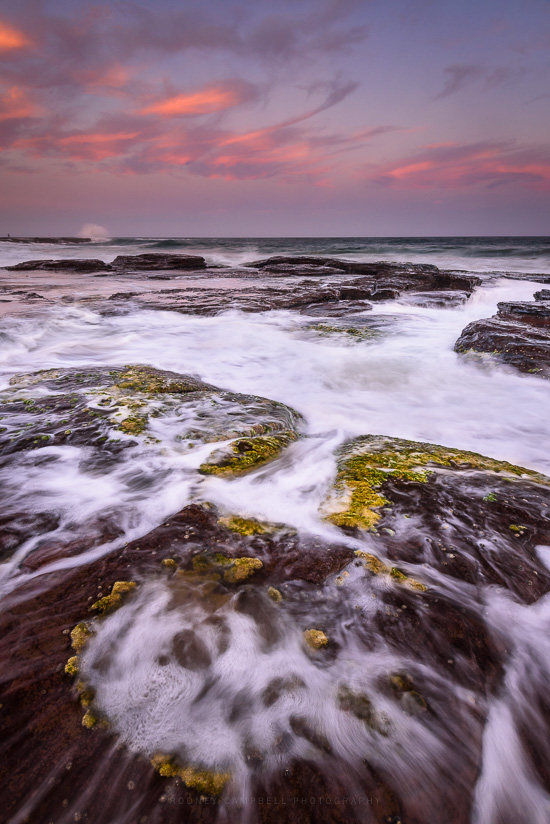What Value in Timing…
by Rodney Campbell on Mar.15, 2016, under Life, Photography
In my previous post detailing our sunset session at Wombarra on the northern edge of Wollongong I mentioned that one of the important aspects of shooting seascapes is timing.
Churn
Timing is definitely not the only thing that is important but it does play it’s part. Below I’ll try to explain why.
Like much of photography choosing an appropriate location is important and then creating your composition. With landscape and seascape photography having a good location with the “right” atmospheric and weather conditions also plays a significant part in the end result. You then need to get your camera settings right, and this may involve things like what focal length choice you make, where the camera is, what aperture, ISO and shutter combination your are going to use, where you are going to focus and so on.
However once all that has been decided (by you) and locked into place you then have a choice of “when” you are going to take the shot. It is this timing of the when that can play a critical factor in what results you end up with.
To explain further we are going to take this image above which I captured as part of my sunset shoot at Wombarra.
Below is a screen grab of my Lightroom Library view for part of this shoot. What you can see here is frame numbers 21 to 40 from the session.
The first 8 frames are the last part of a sequence of seventeen (17) frames from the previous composition. The next ten frames (images 30 to 39) are the ones which represent the frames I took for this current composition (you can see I’ve put these into a stack in my Lightroom catalog). Highlighted is the image you see above which just happens to be the eighth (8th) frame I took in this sequence.
Note: These photographs (especially the wider shots) look much better when larger – so click any of the images below to see larger versions in an inline overlay slideshow gallery viewer.
Before starting this sequence I’d assessed the scene, watched where the clouds would be and where the water flows. I’d imagined what the composition would look like and how I wanted the shot to look. I’d worked out which direction I’d point my camera, what focal length I’d use. Where I’d put my tripod and at what height I’d have the camera. Whether it would be horizontal or vertical and at what angle I’d have the camera and lens. What I’d include in my foreground and where I’d put it, where the horizon would be and so on. I also setup my filters including the polariser and where it would be set at and how much graduated neutral density I needed over the sky.
I’d also worked out where I’d focus (I focused and locked it to manual) and what aperture I’d need for the depth of field I wanted based on focal length, distance to the closest part of the frame and where I’d focused.
Based on the movement of water I’d also decided roughly what shutter speed range I wanted to be in to allow the water to flow through the frame and give me the streaky but still textured water look I wanted (which was roughly in the half second to 2 second range).
At this point I’d adjust the camera settings and see if I needed to do anything else to get the overall exposure I needed. This may involve adding further ND filtering or dropping the ISO if the scene was still too bright to get down to the slower shutter speed I wanted. Conversely if it was too dark I might need to trade some aperture or ISO to bring the shutter speed up (as was the case here).
At this point I’m now set to take the shot and it now comes down to timing. Shooting with moving water in the frame is tricky however because each frame you take can look very different depending on where the water is in the frame, how much water there is and what direction it is moving and so on.
Wash and Tumble
When I say taking a sequence and timing I also don’t mean just spray and pray. Holding the shutter down and taking a repeated sequence of images hoping you’ll get lucky with one of them is not what I mean. I mean looking at the scene, really looking for what is happening and waiting for the moment to start the capture. It’s waiting for the water to be in the right place and moving in the right direction and so on.
You can see looking at my ten (10) frames in grid view how very different the overall image looks when a shot is taken a different times. Here I wanted to see what a shot might look when the rocks were still exposed but the channel was still full of rushing water – sometimes coming in and sometimes when it’s dragging back out. The shot I had in my mind however was where the surge was at it’s peak (from one of those larger rogue waves) and the water was rushing not just through the channel but surging over the edge and spilling over the rocks at my feet towards me.
In the grid you can see some images I short listed as potential candidates (flagged as Yellow) and those I’ve edited (they have a star rating). Finally my favourite version highlighted and posted up the top with the water rushing right over and filling the foreground with a churning streaky wash spreading out towards and past me – job done.









